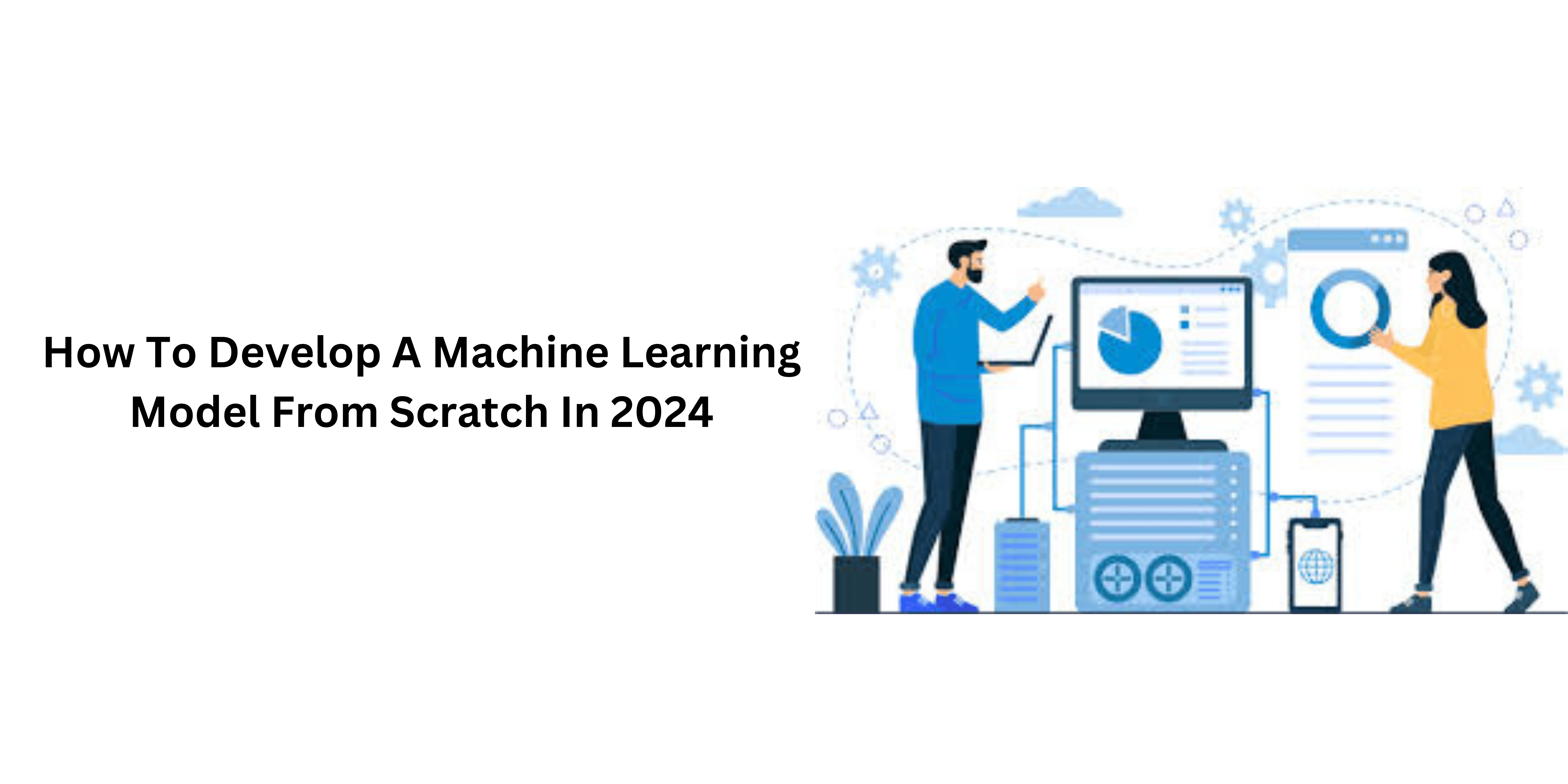2024 is an age of rapid transformation, and machine-learning technology is at the center of it all. Industries and businesses increasingly recognize its transformative potential; hence, the increased need for highly trained specialists providing tailor-made solutions has skyrocketed.
A practical foundation is increasingly vital to machine learning development for individuals and businesses looking to efficiently take full advantage of this burgeoning field. This blog is an in-depth resource for those attempting to construct machine-learning models from scratch.
Becoming adept in machine learning begins with a firm grasp of its fundamental concepts, tools, and methodologies.
Working with an experienced machine learning development company can make all the difference in machine learning development efforts. These specialized firms have knowledge, expertise, and a structured process for effectively meeting goals.
As we explore the fine details of developing machine learning models, consider an experienced Machine Learning Development Company your indispensable ally in aiding and supporting your advancement.
Understanding the Core Concepts of Machine Learning
Machine learning, a part of AI, is about making computers learn and improve their performance based on experience without explicit programming. To grasp the basic principles of machine learning, one must understand its foundational principles: models, algorithms, and data.
The core of machine learning lies in algorithms that act as computational engines that process data, detect patterns, and make educated decision-making. These algorithms can be classified into different types, including unsupervised, supervised, and reinforcement learning, each adapted to specific learning contexts. Knowing the features and functions of these types of algorithms is crucial to developing efficient machine-learning strategies.
Machine learning models represent the learned patterns or relationships incorporated into data. These models may take a variety of models, from linear regressions to more complex neural networks. The most important aspect of developing a model is choosing the best structure for the task. To achieve this balance, you must consider aspects like the complexity of the model, interpretability, and computation efficiency.
Equally important is the importance of data, commonly called the lifeblood of machine learning. The quality, quantity, and relevancy of data significantly impact the effectiveness of a machine-learning model. Cleaning and processing data, studying its features through exploratory data analysis (EDA), and deciding on suitable features are crucial stages in preparing the data to train models.
Understanding machine learning means recognizing the synergy between models, algorithms, and data. This understanding of the fundamentals lays the foundations for mastering sophisticated methods, which will guide the creation of effective and efficient machine learning-based solutions within the constantly changing landscape of technology.
Setting Up Your Development Environment for ML
Creating a properly optimized development environment is an essential initial step for anyone looking to get into machine learning. A seamless environment ensures accuracy and reliability and facilitates the iterative development of models. In 2024, thanks to the variety of available frameworks and tools, creating a secure environment tailored to your particular needs is now easier than ever before.
The first step is to select the correct programming language, which is essential. With its numerous libraries and support for community members, Python is the preferred choice of many machine learning experts. Frameworks such as TensorFlow and PyTorch offer a solid foundation to build and train models for machine learning.
The next step is to have a solid integrative development environment (IDE) that makes it easier to code process. IDEs like Jupyter Notebooks VS Code or PyCharm include features like autocompletion of code, tools for debugging, and visualization tools, which enhance the overall experience for developers.
Tools for containerization, such as Docker, allow the creation of portable and reproducible environments that are portable and reproducible. Developers can collaborate seamlessly and ensure consistency across platforms by creating a container for configurations and dependencies within containers.
Control systems for version control, like Git, are essential to keep track of changes to code and work with other team members. Platforms like GitHub or GitLab offer hosting and collaboration tools for a more efficient and coordinated method for machine learning projects.
Incorporating virtual environments, controlled through tools like Conda and virtual, helps to separate project dependencies, preventing conflicts between projects and providing a tidy and dedicated space for every machine learning project.
By meticulously configuring these components, researchers can create an environment for learning that meets the requirements specific to their machine-learning tasks, encourages collaboration reproducibility, and ensures a smooth process throughout the entire development lifecycle.
Selecting and Preparing Your Dataset
Preparing and selecting a dataset is essential during machine learning development because the data’s quality and relevancy directly affect the model’s performance and generalization. In 2024, with a plethora of data available, this process requires an attentive and thoughtful approach to planning.
The first step is identifying the issue and determining the data needed. Whether it’s structured data in tabular format, unstructured data like images or text, or sequential data, understanding the job’s specifics assists in deciding on the most suitable data set.
When the kind of data is established, the researcher must look into the various data sources. Platforms such as Kaggle, UCI Machine Learning Repository, and government databases offer many datasets. It is crucial to assess the size, diversity, and relevancy of the machine-learning project to ensure that it aligns with its goals.
Data preparation includes cleaning and preprocessing to increase the usability of data. Handling missing values, as well as handling outliers and scaling or normalizing functions, are typical preprocessing steps. This also involves dividing the data into validation, training, and testing sets to assess the algorithm’s performance accurately.
In the case of developing machine learning, the term Machine Learning Development emphasizes the importance of an appropriately curated data set in the project’s overall success. Machine learning algorithms discover patterns and then make predictions from the data in the data, making selecting and preparing essential to the model’s accuracy and efficiency. As technology develops, mastering these elements becomes more important for those who want to master the maze of machine learning development.
Exploratory Data Analysis (EDA) Techniques for Modern ML
Exploratory Data Analysis (EDA) is essential to modern machine learning. It acts as a vital link between raw data and actionable insights. In the ever-changing world of 2024, EDA methods have been developed to deal with the complexity of diverse data sets, allowing researchers to discover pattern patterns and gain better knowledge of available data.
EDA involves a systematic method to statistically and visually examine data to uncover patterns, relationships, and outliers. Visualization tools like Matplotlib, Seaborn, or Plotly are essential in creating meaningful graphs and charts that reveal patterns and patterns within the data.
Utilizing statistical measures, researchers can use statistical descriptives, correlation matrices, and summary statistics to determine the features of the data. This helps identify elements that require further processing, deal with issues such as skewness, and guide decisions regarding the engineering of features.
Advanced EDA techniques for 2024 utilize algorithmic machine learning to get insight. Dimensionality reduction methods like t-distributed neighbor edging (t-SNE) or principal component analysis (PCA) allow the visualization of large-scale data in an understandable format.
The study of relationships in the data goes beyond bivariate and univariate analysis. Multivariate techniques, like clustering algorithms such as k-means or hierarchical clustering, contribute to discovering natural groups within the data.
An extensive EDA process is essential in the constantly evolving world of machine learning in the modern age. It does not just lay the foundations for informed decision-making throughout the development of models but also gives a thorough understanding of the subtleties inherent in the data. As researchers continue to expand the boundaries of what can be achieved in machine learning and machine learning, mastering EDA techniques is a key element to the success of their projects.
Choosing the Right Machine Learning Algorithm for Your Task
The selection of the best algorithms for machine learning is an essential choice in the development process because it has a profound impact on the effectiveness of the model and its capability to tackle particular tasks. In 2024, there will be an extensive range of algorithms to choose from; understanding their strengths and weaknesses and their suitability to various scenarios is vital to developing a successful model.
The most important factor to consider in selecting an algorithm lies in the type of task. Whether it’s a classification, clustering, regression, or reinforcement learning challenge, it doesn’t matter. Every category has an algorithm specifically designed to meet its particular requirements. For instance, decision trees and random forests are ideal for tasks that require classification, while the support vector machine or linear regression is a great choice in the context of regression.
Understanding the dataset’s size and complexity is vital when choosing an algorithm. For large data sets with high dimensionality, gradient-boosting or deep learning algorithms may be better suited, whereas simpler algorithms such as k-nearest neighbor or linear models may be more effective for smaller data.
Practitioners must also take into consideration the ability to interpret the model. Linear models and decision trees can be easily interpreted, making them ideal for situations where model transparency is crucial. However, complicated models like neural networks might have greater precision but are more difficult to comprehend.
Cross-validation techniques, such as cross-validation k-fold, are an accurate method to determine how much an algorithm can be applied to the new, untested data. By comparing the performance of various algorithms using cross-validation techniques, users can make educated decisions on which one best fits the needs of their job.
In the constantly evolving machine learning, keeping up-to-date with new techniques and advances is vital. Continuous learning and testing with various algorithms allow professionals to meet the demands of various situations and use the most efficient solutions to their needs. In the end, selecting the best machine learning method can be a process that requires domain expertise with experimentation and a thorough understanding of the data that underlies it.
Feature Engineering: Enhancing Model Input for Better Performance
Feature engineering is an essential element in the field of machine learning. It plays an essential role in improving the performance of models by improving the input variables models employ to create predictions. As 2024 approaches and the technological sophistication of models for machine learning increases as they improve, feature engineering will be a crucial method of extracting useful information from the raw data.
The process of feature engineering is the transformation and creation or selection of features for input to enhance the ability of a model to detect patterns and connections within the data. This process requires a profound understanding of the area and the challenge at hand, as well as being aware of the features of the data.
One of the most common methods in feature engineering is creating new features by mathematical transformations or aggregating existing ones. For instance, in a time-series data set, extracting features such as moving averages or time delays could offer valuable insights into seasonality and trends.
Controlling categorical variables is yet another crucial element that features engineering. Techniques like one-hot encryption or label encoding can express categorical information in a form that machine learning models can understand efficiently.
Dimensionality reduction techniques like principal component analysis (PCA) and t-distributed stochastic neighbor edging (t-SNE) are powerful techniques in feature engineering, especially when dealing with complex datasets. These methods allow the extraction of crucial information while decreasing the amount of input features, avoiding issues such as overfitting, and improving the generalization of models.
Data Preprocessing and Cleaning Strategies in 2024
In the ever-changing world of 2024, efficient data cleaning and preprocessing strategies are essential to the success of machine learning development services. The quality of the data input greatly affects the effectiveness and reliability of models that use machine learning, which makes meticulously preprocessing data a vital component of data preparation.
Removing missing data is a constant problem, and the most recent methods rely on sophisticated imputation methods like K-Nearest Neighbors or algorithms such as Random Forests to predict missing values based on other characteristics. By imputation of missing values, you can ensure that the data remains accurate and impartial.
Outlier detection and treatment are crucial to ensure that models do not have skewed performance. In 2024, experts will employ solid statistical methods and machine-learning models that can detect and deal with outliers promptly. This ensures that the machine learning model is not excessively affected by data anomalies that may alter the predictions.
Processing categorical data is a crucial component of the preprocessing. Modern techniques such as embeddings or target encoding in deep-learning models give better depictions of categorical variables, improving the model’s capacity to detect patterns.
Scaling and normalization methods ensure that the numerical components are equally involved in model training by preventing specific aspects from dominating due to their size. Standardization techniques, such as Min-Max scaling or Z-score normalization, are commonly used to bring the features to a common scale.
In the case of ML development, adhering to ethical practices in handling data and protecting privacy and security is essential. Strategies include encryption or anonymization of sensitive data and using data governance frameworks to ensure the data’s confidentiality and integrity in the entire preprocessing process.
Machine development and learning companies strive to achieve excellence in 2024. Skilled cleaning strategies and data preprocessing are essential pillars to making the most of data, which will allow the creation of precise, solid, durable, and ethically sound machines.
Model Building: From Simple to Complex Architectures
Modeling is the continuous process in machine learning, which spans from the basic structures to the complexities of sophisticated models. Finding the perfect balance between the complexity of models and their interpretation is the most important factor to consider when navigating the complexities of 2024.
The journey usually starts with simpler models like linear regression or the bare decision tree. These simple structures clarify the connections between the input feature and the variable of interest. They provide a vital base for projects where transparency and clarity are crucial.
As tasks become more complicated, professionals look for more complex structures to detect subtle patterns in the data. Ensemble methods, such as Random Forests, combine multiple simple models to boost the accuracy of predictive models. They can handle non-linear relationships and can defend against overfitting.
Deep learning models, like neural networks, are used when tasks require the highest degree of abstraction and representation learning. Convolutional Neural Networks (CNNs) excel at image processing, as do Recurrent Neural Networks (RNNs), and are proficient in sequentially handling large amounts of data. Transfer learning, where trained models are tuned to specific tasks, draws on the wisdom accumulated from huge databases.
Model development in 2024 requires an in-depth analysis of the trade-offs. Complex models could be highly accurate, but they can be costly and challenging to comprehend. Techniques for regularization, such as dropping out in neural networks, help avoid overfitting in complex structures and achieve the right balance between model complexity and generalization efficiency.
The progression from simple to complex models is governed by the job’s specific needs to be completed. Understanding the subtleties of different models and their applications allows users to make educated choices to ensure that the structure of the model is aligned well with the complexity of the data and goals of the machine learning project.
Hyperparameter Tuning for Optimal Model Performance
The tuning of hyperparameters is an essential element in custom ML model design, focusing on improving the parameters that control the learning process to ensure the best performance. In 2024, when machine learning models become increasingly advanced, fine-tuning these parameters is essential to maximize accuracy and generalization.
Hyperparameters are the external settings that define the behavior of a machine-learning model. Examples include the learning rate, regularization strengths, and the number of neural network layers. Making the best choices for these parameters significantly affects the capacity of the model to adapt and learn from the data it has learned.
Random search and grid search are two common methods used for tuning hyperparameters. Grid search systematically evaluates an established range of hyperparameter configurations, while random search focuses on the possibility of random subset values. Both approaches aim to discover the optimal configuration of hyperparameters for the model’s performance.
Advanced techniques, like Bayesian optimization, use probabilistic models to determine the effectiveness of various hyperparameter settings, thus guiding the search process more effectively. This technique is particularly beneficial when the huge search area and the computational resources are constrained.
In developing custom models for ML, the term Custom ML Model Development emphasizes the necessity of customizing models for specific purposes. Tuning the parameters of hyperparameters, in this case, is not just finding the best settings for conventional algorithms but also investigating the structure and the hyperparameters of customized models to ensure that they’re precisely tailored to the particulars of the problem being solved.
While machine learning continues to develop, hyperparameter optimization is a constantly evolving field and requires a deep knowledge of algorithms, model structures, and the domains of the problem. The success of tailor-made ML model development is based on carefully tuning hyperparameters to ensure that models can perform at their best in meeting the specific issues posed by different datasets and challenging tasks.
Training and Evaluating Your Machine Learning Model
Evaluation and training of the performance of a machine learning model are the main components of the creation process and require a thorough strategy to ensure a robust performance on unidentified data. In 2024’s world, when machine learning models will be used for a myriad of purposes, mastering the complexities of training models and evaluating them is crucial.
Training a machine-learning model involves exposing a labeled dataset that allows the model to discover patterns and connections within the data. The data set is generally divided into validation and training sets, which adjust the model’s parameters, and the latter as a non-dependent performance measure. In 2024, advanced optimization techniques, like stochastic gradient descent, which has a rate of adaptive learning, speed up the speed of convergence of models in training.
After the model has been built, robust evaluation techniques can be used to assess the model’s performance using previously undiscovered data. The metrics used will vary depending on the job’s specifics; for classification, metrics such as accuracy precision, precision, recall, and F1 score are typical for regression, whereas classification tasks could employ metrics like R-squared or mean-squared error.
Cross-validation, where the dataset is split into multiple subsets to train and validate repeatedly, is a thorough evaluation of a model’s generalization capability. In 2024, researchers often employ techniques such as k-fold cross-validation to get reliable performance estimations.
The model evaluation also includes analyzing the metrics of specific subsets of data, like precision-recall curves, ROC curves, or confusion matrices, to get a deeper understanding of the strengths and weaknesses of the model. A rigorous evaluation will ensure the model isn’t overfitting the training data and can make precise predictions for the newest, undiscovered instances.
Effective training and evaluation are the foundation of a successful machine learning model design. The precise control of these processes, using advanced optimization algorithms and extensive evaluation metrics, allows users to develop models that excel in various situations.
Overcoming Common Challenges in ML Development
The maze of machine learning development comes with numerous challenges, and in 2024, at least, overcoming these obstacles is essential for the successful development of any project. When creating models to classify and analyze regression or more complex tasks, experts must be proficient in overcoming common hurdles to create solid and efficient solutions. The most important partner in this endeavor is a competent custom machine learning development company providing expertise and custom solutions to tackle the challenges successfully.
A common issue is the problem of dimensionality. This is especially true when dealing with large-sized datasets. Methods such as using feature selection, reducing dimensionality, and utilizing algorithms that can handle large dimensions can help overcome the problem, ensuring that models can effectively learn patterns without becoming overwhelmed.
Another problem is dealing with imbalanced data, in which one group has a higher percentage of other classes. To address this issue, it is necessary to employ methods like resampling, creating synthetic samples, or using specific algorithms designed to deal with the imbalanced data. The aim is to stop the models from being biased toward most people.
Interpretable models are commonly popular, but getting them to be interpretable is becoming more difficult with the advent of complicated algorithms such as deep neural networks. Interpretability tools that are model-agnostic, like LIME and SHAP, give insight into the decisions made by models that improve transparency and comprehension.
Privacy and ethical concerns regarding data provide an additional layer of complexity. Finding a balance between the accuracy of models and protecting sensitive data requires using privacy-preserving methods such as anonymization techniques and robust data governance methods.
A machine learning development firm plays an essential role in overcoming these issues by customizing solutions to meet the particular requirements of a project. Their experience in selecting algorithms and feature engineering, as well as ethical considerations, aid in the success of the deployment of machine learning algorithms and ensure they meet the highest standards for quality, interpretability, and ethical conformity. The collaboration of these experts is becoming increasingly essential to meet the ever-changing challenges in machine learning research and development.
Staying Current with the Newest Frameworks and Tools
Being up-to-date with the latest technologies and platforms is essential to succeed in the constantly evolving world of machine learning technology development. In 2024, the fast speed of technological advancement continues to bring new technology that improves effectiveness, scalability, and capability in machine learning. Making the necessary adjustments to these developments is vital for professionals looking to create cutting-edge and efficient machine-learning solutions.
Frameworks and open-source tools have an important role in the machine-learning ecosystem. Platforms such as TensorFlow, PyTorch, and sci-kit-learn keep updated with the latest features, optimizations, and algorithms. Continuously monitoring releases and discussions in the community allows users to use the most current features and improve their modeling workflows.
Containerization technologies, such as Docker, help improve machine learning systems’ transferability and reproducibility. Awareness of container updates helps practitioners effectively package and deploy models across different computing environments.
Cloud services like AWS, Google Cloud, and Microsoft Azure frequently introduce novel services for machine learning and infrastructure improvements. Staying current with these changes will allow users to benefit from the potential of cloud computing to facilitate scaling model training deployment, monitoring, and deployment.
Online learning platforms, continuous learning classes, and conferences are valuable sources to stay up-to-date on new frameworks and tools. Connecting with the larger machine-learning community via forums, meetups, or collaborative projects promotes a lively sharing of information and knowledge.
In today’s fast-paced world of machine learning, a commitment to ongoing training and exploring new technologies is a mark for successful professionals. By embracing a constantly learning culture, experts will not only stay abreast with the most recent advancements but also contribute to the collective advancement of machine learning.
The Key Takeaway
In conclusion, embarking upon machine-learning development by 2024 requires an integrated approach incorporating fundamental principles, cutting-edge methods, and a commitment to being informed. The dynamism of the field, accentuated by the rapid advancement of technology, requires continual learning and apprehension. As professionals move from understanding the fundamentals to applying advanced models, the term Custom AI/Machine Learning Solutions appears to direct users toward customized and efficient methods.
The process begins by understanding the basic notions underlying machine learning, from algorithms to models, and the vital role played by data. Setting up a strong development environment, identifying and preparing data sets, and conducting an exploratory analysis of data sets are the foundations for model development. The choice of the appropriate machine learning technique, then careful feature engineering, shows the expert’s ability to harness the intricate details of data for the best performance of models.
The trend continues to evolve with data processing and cleaning techniques, in which ethical considerations are becoming more crucial. As models move from primary to advanced architectures, the significance of tuning the parameters for exact customization is balanced. Training and testing the model are crucial checkpoints to ensure that the model aligns with the requirements of the real world.
Problems, ranging from dimensionality concerns to data privacy concerns, are handled with skill, and the significance of a skilled “Custom AI/Machine Learning Solutions” company is apparent when crafting customized solutions. To overcome these obstacles, you need an amalgamation of imagination, domain knowledge, and the application of modern techniques and frameworks. This demonstrates the dedication to excellence in the ever-changing world of machine learning.
In the constant quest for new technology and innovation, the process concludes by urging you to stay alert to the latest developments. Continuous training ensures that employees can navigate the constantly changing landscape of machine learning technology and provide standard solutions and custom-designed, innovative, and advanced “Custom AI/Machine Learning Solutions” with a profound impression.











